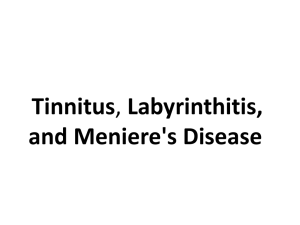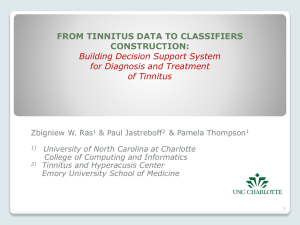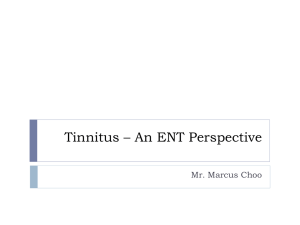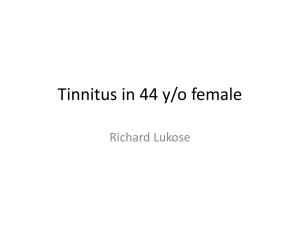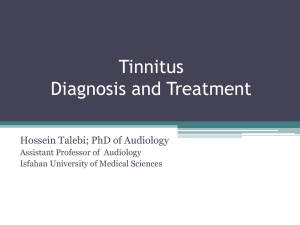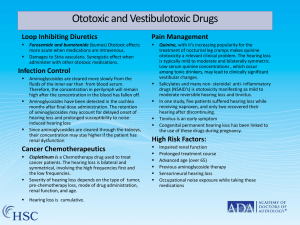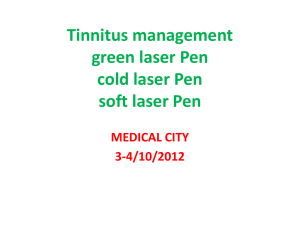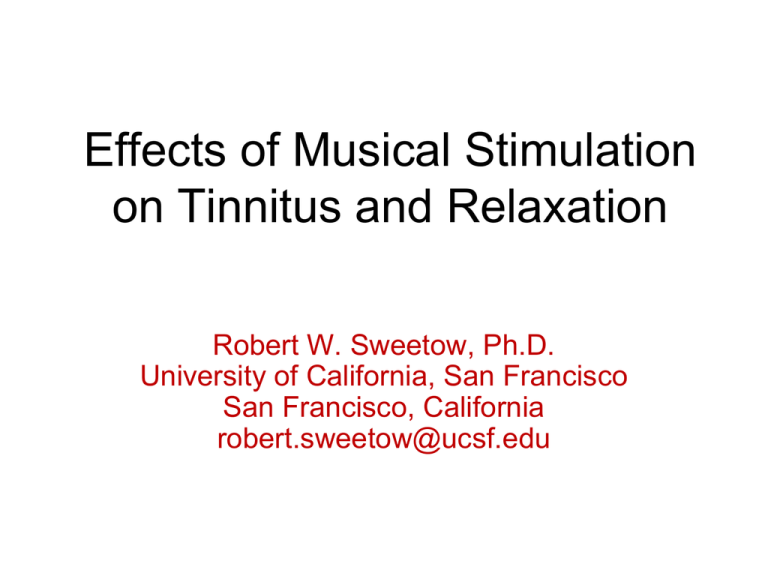
Effects of Musical Stimulation
on Tinnitus and Relaxation
Robert W. Sweetow, Ph.D.
University of California, San Francisco
San Francisco, California
robert.sweetow@ucsf.edu
Tinnitus Facts
• Approximately 15% of the world’s
population has tinnitus.
• More than 70% of hearing impaired
individuals have had tinnitus at some point
• 80-90% of tinnitus patients have some
evidence of hearing loss
• 10 - 20% of tinnitus sufferers seek medical
attention
Figure 2. Incidence of tinnitus by age group.
Kochkin et al, 2012
Tinnitus and Hearing Loss
Odds of Having Tinnitus
0
HL at 4k Hz
5
10
15
20
25
30
10-19 dB
20-29 dB
30-39 dB
40-49 dB
50-59 dB
60-69 dB
70-79 dB
> 80 dB
Correlation between tinnitus
severity and auditory threshold
Tinnitus symptom severity and best
hearing threshold
Best hearing threshold at
FREQmax
80
70
60
50
40
30
20
10
0
0
20
40
60
80
100
120
Tinnitus Handicap Inventory Score
Tsai, Cheung, and
Sweetow, 2007
Restricted cochlear lesions in adult animals
produce a dynamic reorganization of the
representation, or map, of the cochlea in the
primary auditory cortex
AUDITORY CORTEX
LOW
MID
http://www.sickkids.on.ca/otolaryngology/EVOKD-PT.asp
Cat Auditory Cortex
Post-Lesion
14 16 18
12
6
8
M
I
D
LOW
Pre-Lesion
HIGH
LOW
MID
20 24 26 28
6
8
12 14 18
1 mm
Frequency (kHz)
Irvine and Rajan (1995)
Psychological contributions
– Cognition: maladaptive cognitive strategies “The
reaction is the key to whether a person with tinnitus
becomes a tinnitus patient” (Sweetow, 1986; 2000)
– Habituation: intolerance results from individual’s
failure to adapt (Hallam et al, 1984; 2006)
– Attention: failure to shift attention away from tinnitus
(Hallam and McKenna, 2006)
– Enhanced tinnitus perception is learned response
resulting from “negative” emotional reinforcement
involving limbic system and autonomic activation
(Hallum;Jastreboff and Hazell, 1993; McKenna,
2004)…..de-emphasizes connection with peripheral
hearing loss
Influence of noise and stress on probability
of having tinnitus
• N = 12, 166 ; N with tinnitus) = 2,024 (16%)
• Each year of age increased the odds ratio of tinnitus by about
3%.
• Men generally showed a higher risk for tinnitus compared with
women.
• Exposure to noise and stress were important for the
probability and level of discomfort from tinnitus. However, for
the transition from mild to severe tinnitus, stress turned out to
be more important.
• Reduction of likelihood of tinnitus if noise is removed = 27%,
if stress is removed =19%), if both removed = 42%.
• Conclusions: Stress management strategies should be
included in hearing conservation programs, especially for
individuals with mild tinnitus who report a high stress load.
– Baigi, et al; Ear and Hearing 2011. 32, 6:787-789
Modern theories of tinnitus origin
• Disruption of auditory input (e.g., hearing loss) and
resultant increased gain (activity) within the central
auditory system (including the dorsal cochlear
nucleus and auditory cortex)
• Decrease in inhibitory (efferent) function
• Over-representation of edge-frequencies (cortical
plasticity)
• Dysfunctional gating in basal ganglia
• Other somatosensory influences (cervical
disturbances, etc.)
• Increased attention related to reticular activating
system involvement
• Association with fear and threat (limbic system)
Tinnitus is associated with abnormal EEGpatterns, showing enhanced activity in the δ
band and reduced activity in the α band (Weisz,
Moratti, Meinzer, Dohrmann, & Elbert, 2005)
MEG data indicating that subjects with
tinnitus
< 4 years have gamma network predominantly
in the temporal cortex; but subjects with
tinnitus of a longer duration show a widely
distributed gamma network into the frontal
and parietal regions (deRidder, 2011)
Revised habituation model
Perception & Evaluation
Auditory and Other Cortical Centers
Detection
(Subcortical)
Abnormal
gating
Emotional Associations
Limbic System, Frontal
lobe (rostral anterior
cingulate cortex)
Annoyancee
Enabler
(Impaired cochlea is one example of a factor creating neural instructions for tinnitus percepts)
Dashed lines represent neutral interpretation of tinnitus percept.
Three aspects of tinnitus that
should be addressed
• auditory
• attentional
• emotional
Assessment Inventories
•
•
•
•
•
•
Tinnitus Severity Scale - Sweetow and Levy
Tinnitus Handicap Inventory - Newman et al
Tinnitus Handicap Questionnaire - Kuk, et al
Tinnitus Effects Questionnaire - Hallam, et al
Tinnitus Reaction Questionnaire - Wilson, et al
Tinnitus Cognitive Questionnaire (TCQ) - Wilson and
Henry
• Tinnitus Functional Index – Miekle, et al
Defining the tinnitus problem
•
•
•
•
time
behaviors affected
attitudes and thoughts
what affects the tinnitus?
Tinnitus triggers
• Physical (viral, medication, hearing
loss (imbalance between
excitatory and inhibitory neurons),
neurotoxicity from noise, somatic
influences)
• psychological
• retirement syndrome
• stress related
Tinnitus Therapies
Reduce Contrast
Mask Phantom Percept
Suppress Hyperactivity
Reclassify Phantom Percept
Reduce Saliency
Mitigate Emotional Distress
Examples
Examples
Maskers
o Hearing Aids
o “Neuromonics”
o “Zen” Fractal tones
o“Sound Cure”
o“Co-ordinated Reset
Stimulation”
o Cochlear Implants
Tinnitus Retraining
o Neuromonics
o Widex Zen Therapy
o Antidepressants
o Cognitive-behavioral therapy
o Mindfulness Based Stress
Reduction
o
o
Auditory-Striatal-Limbic Connectivity
Disrupt Information Conveyance
Avoid Interference with Audition
Examples
Striatal Neuromodulation
o Vagal nerve stimulation
o Cortical Stimulation
(rTMS)
o
“Reasonable” tinnitus patient management
procedures
• Counseling
– Reassurance (including placebo)
– Education
– Cognitive-Behavioral Therapy
• Sound enrichment
– Masking or mixing
– Amplification
• Combination
– Desensitization / Habituation (TRT)
– Neuromonics acoustic desensitization protocol
– Fractal tones
Current sound treatments
•
•
•
•
Noise generators
Maskers
Music (unfiltered, filtered, fractal)
Hearing aids (effective in over 60% of
cases)
• Combination instruments
• Home based
• CDs (e.g. Personal Growth Tinnitus Relief,
Petroff DTM)
Conclusions of Kochkin, et al; 2011
• Of the nine tinnitus treatment methods assessed, none were
tried by more than 7% of the subjects.
• Treatment methods rated with substantial tinnitus
amelioration were hearing aids (34%) and music (30%).
• Subjects who had their hearing aids fit by professionals using
comprehensive hearing aid fitting protocols are nearly twice
as likely to experience tinnitus relief than respondents fit by
hearing care professionals using minimalist hearing aid fitting
protocols.
• This study confirms that the provision of hearing aids
offers substantial benefit to a significant number of
people suffering from tinnitus. This fact should be more
widely acknowledged in both the audiological and
medical communities.
– Kochkin S., Tyler R., Born J. MarkeTrak VIII: The Prevalence of
Tinnitus in the United States and the Self-reported Efficacy of
Various Treatments Hearing Review. 2011;18(12):10-27.
Why hearing aids may help tinnitus patients
• Greater neural activity allows brain to correct for
abnormal reduced inhibition
• Enriched sound environment may prevent
maladaptive cortical reorganization
• Alter production peripherally and/or centrally
• Reduce contrast to quiet
• Partially mask tinnitus
• Fatigue and stress is reduced allowing more
resources to be allocated to tinnitus fight
• All of the above may facilitate habituation
and
• The majority of tinnitus sufferers have at least
some degree of hearing loss
What are the objectives of sound
therapy?
•
•
•
•
•
•
Complete masking
Partial masking
Mix
Habituate
Distract
Suppress
Habituation
• the process of "ignoring" (or becoming
accustomed to) a stimulus without
exerting any conscious effort.
• from a psychological perspective, it is
defined as the adaptation, or decline of
a conditioned response, to a stimulus
following repeated exposure to that
stimulus.
Basic assumptions
•
The brain can sort out meaningful
stimuli from those which are not
• Attention is directed toward
"salient" or information-bearing
stimuli
The Limbic System
Examples of normal habituation
•
•
•
•
Ring on your finger
Clothing
Refrigerator humming
Rear end (buttocks) in your chair
How sensory systems suppress
stimuli
• Somatosensory
• Auditory
• How brain (limbic system) determines
importance of external stimuli
– Thunder versus soft, unexpected sound
Sound enrichment for
desensitization / habituation
• low level noise interferes with pattern
recognition by increasing neuronal activity
• this makes tinnitus more difficult to detect
• gradually increasing input could decrease
gain over an extended time
• Some (Jastreboff) suggests 24 hours a
day, 7 days a week
• Others (Neuromonics) claim 2-4 hours
adequate
Arguments against masking
• Jastreboff
• Tyler
Transient form of suppression is
residual inhibition
Differences between masking and
suppression
• the signal used to facilitate suppression is softer than the
tinnitus perception
• time course …..Masking of tinnitus is instantaneous,
while suppression of tinnitus requires from several
seconds to several minutes to both occur and then
decay.
– this suggests different neural mechanisms for the two
methods.
• maskers typically have similar spectral and temporal
properties to the tinnitus, whereas the most effective
suppressor may have distinctly different spectral and
temporal properties than the perceived tinnitus.
• suppression is a physiologic process in which sounds
may modulate the activity of the auditory cortex and
interrupt tinnitus generation.
TINNITUS SUPPRESSION BY LOWRATE MODULATED SOUNDS
Vanessa S. Rothholtz, Qing Tang, Kelly
M. Reavis, Jeff Carroll, Edward C. Wu,
Esther Fine, Hamid R. Djalilian, FanGang Zeng
How does suppression differ from masking?
• Effective tinnitus suppressors are often softer and have
different temporal and spectral properties than the
perceived tinnitus, whereas maskers are often presented
at an equal level and share similar temporal and spectral
properties as the perceived tinnitus.
• It has been hypothesized that tinnitus may reflect
abnormal, most likely overly synchronized, neural activity
in the auditory cortex.
• Liang and Lu report that low-rate amplitude- or frequencymodulated acoustic sounds produce sustained and highly
synchronized cortical responses.
• External stimulus, particularly an amplitude- or frequencymodulated stimulus, can produce cortical activity that will
compete with the tinnitus-induced neuronal activity by
introducing synchronization of the population of neurons
generating tinnitus.
Conclusions
• Subjects who experienced suppression
reported louder tinnitus (db SL) at baseline
• Best stimuli were amplitude modulated
pure tones with carrier frequencies
between 6K and 9K
• White noise is ineffective as a suppressor
• For subjects with any suppression, AM
and FM pure tones were more likely to
yield total suppression compared to unmodulated pure tones
“Comparison of Custom Sounds for
Achieving Tinnitus Relief”
Henry, et al. Journal of the American Academy of Audiology;
15,8, 2004
CDs used
• Moses/Lang CD7, (1993)
– noise bands covering seven different
frequency ranges —user selects most
effective band
– (Johnson,1998; Vernon and Meikle, 2000)
• Dynamic Tinnitus Mitigation (DTM-6a)
– Petroff Audio Technologies, Inc. (Marina Del Rey,CA;
petroffml@aol.com)
Sample sounds
•
•
•
•
•
E- water (dynamic)
E- air
E- nature (dynamic)
White noise
Personal Growth high frequency relief
DTM
• DTM sounds use proprietary “dynamic”
(changing) sound formats that are intended to
enhance masking and distract attention away
from tinnitus.
• “Dynamic” acoustic technology refers to
proprietary semi-random, short-term amplitude
and frequency domain modulation signal
processing
• E-Nature and E-Water, have been “dynamically”
processed to provide expanded amplitude peaks
on the order of 5 to 15 dB, over corresponding
time durations on the order of 10 to 500 msec.
Differences between E-Nature, E-Water , and EAir
• E-Air = E-Nature when measured in 2
dimensions (amplitude/frequency)
• When measured in 3 dimensions E-Nature is
dynamic
• E-Water is significantly rolled-off in highfrequency amplitude relative to E-Air, so we
would expect E-Air to provide better masking.
• E-Air should have performed at least as well if
not better but this didn’t happen; perhaps
because E-air was dynamic????
Problems with this study
•
•
•
•
Presentations lasted from 3-30 seconds
Study was done in a sound booth
Hearing loss amongst subjects varied
TDH 50s, which have significantly reduced
amplitude from ~ 7-13KHz, were used
Does acoustic therapy help?
• McKinney, et al; 1999
– Counseling only; 72% showed “improvement” (N=54)
– Counseling with sound generators at just audible
level; 75% showed “improvement” (N=72)
– Counseling with hearing aids; 61% showed
“improvement” (N=56)
– Counseling with sound generators at mixing level;
83% showed “improvement” (N = only 36)
Does acoustic therapy help?
• Herraiz, et al, 1999
– Counseling only; 94% showed “improvement”
(N ~ 30)
– Counseling with hearing aids; 85% showed
“improvement” (N ~ 35)
– Counseling with sound generators; 83%
showed “improvement” (N ~ 30)
My conclusion….not definitive proof….yet 70%
of TRT users get them! But, these were done
with white noise.
Counseling only
= 3 worse, 6
same, 6 better
(50%)
Masking = 2
same, 4 better
(66%)
Retraining = 5
same, 6 better
(54%)
Tyler, 2010
Counsel only =
8 same; 10
better (55%)
Counsel + total
mask = 2 same;
9 better (81%)
Counsel +
partial mask =
12 same; 10
better (45%)
Tyler, 2010
•
Both TRT and general counseling without
additional sound therapy are effective in
reducing the annoyance and impact of
tinnitus.
•
The largest effect on overall tinnitus
handicap was observed in the TRT
participants, with an effect size of 1.13.
However, a clinically significant effect was
also observed in the control group, with an
effect size of 0.78.
Effect of Tinnitus Retraining Therapy on the Loudness and
Annoyance of Tinnitus: A Controlled Trial; Bauer, Carol A.; Brozoski,
Thomas J. Ear & Hearing: March/April 2011 - Volume 32 - Issue 2 pp 145-155
Weakness of group data and randomization
• Group analysis assumes all are the same
• Some individuals show large changes, but
these are diluted in group analysis
• There is not likely a single treatment which
confers universal benefit
• Subjects who do not want a device, but
who are randomized to a device group are
less likely to show benefit
• Tyler, 2010
Goal ...
Active listening
(Distraction)
Masking
Desensitization
(Habituation)
Music
iPoD
Radio
Neuromonics, phase 1
Radio or iPod (filtered
or unfiltered)
Amplisound combo
Neuromonics, phase 2
iPoD
Fractal
Speech
Books on tape
Spouse (just joking)
Hearing aids
Misc
TV
Meditation
DTM
Personal Growth
DTM
Shower
TRT, sound
enrichment
Noise
Ocean waves
Narrow band maskers Broad band noise
generator
Fan
Melmedtronics Inhibitor
Ultra Quiet, HiSonic
Stimuli
A perfect example of an auditory
disorder closely related to stress:
Tinnitus
• Music has been shown to activate the
limbic system and other brain structures
(including the frontal lobe and cerebellum)
and has been shown to produce
physiologic changes associated with
relaxation and stress relief.
Where is music processed?
Frontal
Lobe
How is music used?
•
•
•
•
•
•
•
•
•
•
•
Home
Work
Celebrations
Advertising
Romance
Movies
Athletic locker rooms
Shopping malls
Hospitals
Therapies
Relaxation
Modes of Delivery
•
•
•
•
Home stereo
iPod
Neuromonics
Hearing aids
“Rules” of music and emotions
• Slow onset, long, quiet sounds – calming
• Music with a slow tempo (i.e. near natural heart
rate (60 – 72 beats per minute) - relaxing
• Repetition - emotionally satisfying
Categorical Expectations
• We don’t like the unexpected
• But certain rules have to be followed
• Active listening may arouse, passive
listening may soothe
• For tinnitus patients, active listening may
draw attention to the tinnitus, passive
listening may facilitate habituation
Neuromonics
• a bit of cognitive therapy
• A bit of TRT
• Music therapy (for affect and relaxation) and
wide band stimulation using a iPod-like
processor with Bang and Olufsen earphones
• Rhythm
• Hearing instrument algorithm (equal sensation
level) for hearing loss compensation
• 2 stage program
• expensive
Neuromonics
Comparison of sound generators (SGs) vs Neuromonics
tinnitus treatment (NTT)
•
N= 56; 6 month trial
•
Both groups (SG and NTT) demonstrated a significant reduction in tinnitus for SG
and NTTs. However, there were no differences in the SG or NTT treatment groups.
•
Conclusions: Both protocols (SG and NTT) yielded significant improvements with
regard to quality of life (HRQoL) issues, based on the THI improvements
•
SG appears to be more cost efficient than NTT. “The cost per unit of improvement
(treatment utility) on the THI (scale from 1–100 points) measured in “quality-adjusted
life years” was $604 per point for the sound generator treatment compared to $1,771
per point for the neuromonics treatment. The implication here is that equivalent gains
might be obtained at a lesser cost to the patient.”
Newman CW, Sandridge SA. (2012) A Comparison of benefit and Economic
Value Between Two Sound Therapy Tinnitus Management Options. Journal of
the American Academy of Audiology 23:126–138.
Independent results for Neuromonics tinnitus treatment
protocol
•
Forty-seven patients initiated treatment with the Neuromonics device during the 2 year
study period.
•
Fourteen patients completed treatment, and another 18 were actively undergoing treatment
at the end of the study period.
•
The mean pure-tone average (N 47) = 23.4 dB for the involved ear.
•
Of those who completed the treatment, the mean posttreatment TRQ score was
significantly lower than the pretreatment score ( p ~ .001).
•
Fifteen patients (31.9%) returned the device or did not complete treatment.
•
Across all 47 patients, 48.9% achieved a successful reduction of 40% or greater in TRQ
score.
No correlation among pure-tone average, initial TRQ score or duration of use, and
percentage change in TRQ score for those with at least one follow-up test.
•
Goddard JC, Berliner K, Luxford WM. Recent Experience with the
Neuromonics Tinnitus Treatment. Int Tinnitus J. 2009;15(2):168-173
Why can’t we just use an iPod?
• Frequency shaping
• Loudness balance
• Compression
Studies (citation) have shown that baroque music at 60
beats per minute causes your brain to produce more alpha
brainwaves. Some specific examples of good relaxation
music.
• "Harpsichord Concerto in F Minor," by J.S. Bach
• "Concerto No.10 in F Major from Twelve Concerti Grossi," by A.
Corelli
• "Winter" from "The Four Seasons," by A. Vivaldi
• "Canon in D," by Pachelbel
• "Adagio in G Minor for Strings," by Albinoni
Read more: http://www.articlesbase.com/stress-managementarticles/the-best-relaxation-music-541489.html#ixzz1TLaTSXjT
Under Creative Commons License: Attribution No Derivatives
• http://www.healingcombattrauma.com/2008/06/using-sound-healingfor-ptsd.html
Target processing
1 octave notch around
Tinnitus frequency.
Same processing on both ears
Placebo processing
1 octave notch elsewhere
No notch at tinnitus frequency
Okamoto H et al. PNAS 2010;107:1207-1210
Selecting the right sounds
Sounds (including music) affects people in
different ways, due to inherent, learned (and
cultural) preferences
Thus it is appropriate to use relaxing
background sounds (that activate the
parasympathetic division of the autonomic
nervous system) and minimize exposure to
alerting, negative, or annoying sounds (that
activate the sympathetic division)
Cultural preferences (Bolero)
Earworms?
Considerations
• For relaxation
– Music with a rhythm slower than your natural heart rate (72 beats
per minute) is useful to many people
– Lower pitches are more calming than higher pitches, generally
speaking
• For focus and concentration
– No distraction
– Personal preference
– Few emotional tags
• For tinnitus
– Active listening (distraction)
– Masking (covering up)
– Passive listening (habituation, desensitization)
Definition of fractal
• "a rough or fragmented geometric shape
that can be split into parts, each of which
is (at least approximately) a reduced-size
copy of the whole”
• Properties include self-similarity and a
simple and recursive definition
Fractals in nature
• Examples include:
– clouds, rivers, fault lines, mountain ranges,
craters, snow flakes, crystals, lightning,
cauliflower, broccoli, blood vessels, ocean
waves and DNA
• Fractal tones create a melodic chain of
tones that repeat enough to sound familiar
and follow appropriate rules, but vary
enough to not be predictable.
• Fractal technology ensures that no sudden
changes appear in tonality or tempo
Disclosure
Zen
• An optional listening program in certain (Passion, Mind,
and Clear) Widex hearing aids that plays adjustable,
continuous, chime-like tone complexes using fractal
algorithms.
• The chimes are generated based on an understanding of
the properties of music that would be most relaxing
(Robb et al., 1995):
•
•
•
•
•
•
•
Ability to self select music.
Tempo near or below resting heart rate (60-72 bpm).
Fluid melodic movement.
Variety of pitches
No rapid amplitude changes
Element of uncertainty (Beauvous 2007)
Passive listening
• Each Zen program can be individually
adjusted to loudness, pitch and tempo
preferences
• The fractal tones (or the noise) should be
audible, but relatively soft
• It should never interfere with
conversational speech
• The annoyance level of the tinnitus should
just begin to decrease (i.e., tinnitus can
still be audible)
Frequency response and amplitude settings are based on in-situ audiogram.
A filtered broad band noise can be used as a separate program or in combination with the fractal
tones.
Signals are dichotic
Evidence of effectiveness
• Sweetow & Henderson-Sabes, The use of
acoustic stimuli in tinnitus management.
JAAA 21,7, 461-473, 2010
• Kuk F, Peeters H, Lau CL. The efficacy of
fractal music employed in hearing aids for
tinnitus management. Hearing Review.
2010;17(10):32-42.
• Herzfeld and Kuk, Hearing Review, 2011;
18,(11), 50-55.
•14 subjects with severe, uncompensated
tinnitus, 6 non-tinnitus subjects. 2 subjects
dropped out.
• All subjects had tinnitus for at least one
year and had received no active treatments
(including counseling) for at least three
months prior to the start of the experiment.
0
20
dB HL
• All tinnitus subjects had been seen at
UCSF for tinnitus treatment at least 3 mos.
prior to the study – completed tinnitus
counseling and other therapies but were
still significantly bothered (average THI
entering study = 58.7).
40
60
80
100
500
1000
2000
4000
Frequency (Hz)
• Battery of questionnaires = THI, TRQ,
stress, annoyance, and relaxation measures.
8000
Study Questions
• Would fractal tones (and/or noise)
delivered through hearing aids be:
– Perceived as relaxing to tinnitus patients?
– Reduce short term tinnitus annoyance in the
lab?
– Lower subjective tinnitus handicap and
reaction scores in a 6 month field trial?
Relaxation ratings
1 – very relaxing, 2 – somewhat relaxing, 3 – neither relaxing nor stressful,
4 – somewhat tensing, 5 – very tensing
Relaxation Rating
5
4
3
2
1
More Relaxed
0
Aqua
Coral
Lavender
Green
Relaxation ratings
1 – very relaxing, 2 – somewhat relaxing, 3 – neither relaxing nor stressful,
4 – somewhat tensing, 5 – very tensing
Relaxation Rating
5
4
3
2
1
More Relaxed
0
Zen alone
Zen+Master
Zen+Master+Noise
Tinnitus annoyance
0 – no annoyance, 1 – just slightly annoying, 2 – mildly annoying, 3- moderately annoying,
4 – very annoying, 5 – extremely annoying, 6 – worst possible annoyance
Tinnitus Annoyance Rating
6
5
4
3
2
1
0
Less Annoying
-1
Unaided Master
Aqua
Coral
Lavender Green
Noise
Tinnitus Handicap Inventory
Herzfield and Kuk, 2011 (48 subjects receiving counseling plus
Summary of findings
• Fractal tones were effective as a tool in
promoting relaxation and reducing
annoyance from tinnitus
• Both fractal tones and noise reduced
tinnitus annoyance, but the fractal
tones were preferred by subjects for
longer term use
Widex Zen Therapy
• an integrated program addressing all 3 major
components of tinnitus distress; auditory,
attention, and emotion.
• many patients will be adequately served by
counseling and sound therapy (hearing aids,
fractal tones, or noise) alone
• patients with nnegative reactions treated
with a comprehensive program integrating
cognitive-behavioral concepts and relaxation
exercises along with the counseling and
acoustic tools.
The overall objective of Widex
Zen Therapy…..
• is to ensure that the tinnitus does
not negatively impact the patient's
quality of life!
• it is not designed to be a cure, or
to suppress tinnitus (though it
sometimes produces that effect).
Components
1. Counseling to educate the patient and assist the
limbic system to alter its negative interpretation of
the tinnitus via cognitive and behavioral
intervention;
2. Amplification (binaurally, when appropriate) to
stimulate the ears and brain in order to discourage
increased in central activity (overcompensation)
and maladaptive cortical reorganization;
3. Fractal tones binaurally delivered to the patient in a
discreet, inconspicuous and convenient manner,
designed to both relax and provide acoustic
stimulation;
4. Relaxation strategy program highlighted by
behavioral exercises and sleep management
Counseling
• Instructional
• Adjustment-based
Counseling
• Instructional counseling helps educate the patient
about aspects of the tinnitus itself. For example, it
addresses…………..
– the basic anatomy and physiology of the auditory
(and central nervous) system,
– why the tinnitus is present (particularly when it is
a normal consequence of having a hearing loss),
– what the logical course of the tinnitus might be,
– how the limbic system affects the tinnitus
perception and how the patient’s reaction impacts
the ability to cope with or habituate to the tinnitus.
Adjustment based
counseling…
• Helps the patient recognize aspects about how
the tinnitus is affecting him or her, and the
cognitive and behavioral implications. It is
designed to :
• address the emotional sequelae of tinnitus,
including fear, anxiety and depression;
• identify and correct maladaptive thoughts and
behaviors;
• understand the relationship between tinnitus,
stress, fear, behaviors, thoughts, and quality
of life.
Cognitive behavioral intervention….
• is designed to identify the unwanted thoughts and
behaviors hindering natural habituation, challenge their
validity, and replace them with alternative and logical
thoughts and behaviors.
• the objective is to remove inappropriate beliefs, anxieties
and fears and to help the patient recognize that it is not the
tinnitus itself that is producing these beliefs, it is the
patient's reaction (and all reactions are subject to
modification).
The basic processes in cognitive-behavioral intervention are :
• identify behaviors and thoughts affected by the tinnitus;
• list maladaptive strategies and cognitive distortions
currently employed;
• challenge the patient to identify negative thoughts;
• identify alternate thoughts, behaviors, and strategies.
Awareness of tinnitus
Cognitions (Automatic thoughts)
Emotional state
(anger, depression, anxiety)
Emotional response is the result of the
thoughts, not the event (awareness of the
tinnitus) itself.
Some suggestions….
• Ask “what will make this encounter or
therapy successful in your mind?”
• Remember that tinnitus patient
management is a journey, remind patients
of the ups and downs to be expected
• Tell patient that 1st thought upon
recognizing tinnitus should be…..
Relaxation Exercises
• Progressive Muscle Relaxation
• Deep breathing
• Guided imagery
General suggestions for the relaxation
exercises:
• Perform the exercises while sitting in a
comfortable chair in a quiet place with no
distractions;
• Do the exercises while listening to the Zen tones,
but if you are too distracted, turn off the tones;
• Remove your shoes and wear loose, comfortable
clothing;
• Don't worry if you fall asleep;
• After finishing the exercise, close your eyes, relax
for a few minutes, breathe deeply and rise up
slowly.
• * NOTE: IF YOU HAVE MEDICAL CONDITIONS
THAT MAY CAUSE YOU TO EXPERIENCE
DISCOMFORT ASK YOUR PHYSICIAN BEFORE
DOING THESE EXERCISES
Progressive Muscle Relaxation (PMR):
•
PMR consists of alternating deliberately tensing muscle groups and then
releasing the tension. Focus on the muscle group; for example, your right
foot. Then inhale and simply tighten the muscles as hard as you can for
about 8 seconds. Try to only tense the muscle group that you are
concentrating on. Feel the tension. Then release by suddenly letting go.
Let the tightness and pain flow out of the muscles while you slowly
exhale. Focus on the difference between tension and relaxation.
•
•
•
•
•
•
•
•
•
•
•
•
•
•
head (facial grimace)
neck and shoulders
chest
stomach
right upper arm
right hand
left upper arm
left hand
buttocks
right upper leg
right foot
left upper leg
left foot
Relax for about 10-15 seconds and repeat the progression. The entire exercise should take about
5 minutes.
DO NOT DO IF YOU HAVE HIGH BLOOD PRESSURE
•
Deep breathing:
• This is the simplest of the relaxation procedures. It
simply requires you to follow the five suggestions
above and to add deep, rhythmic breathing.
Specifically, you should complete the following
cycle 20 times:
• Exhale completely through your mouth;
• Inhale through your nose for four seconds (count
"one thousand one, one thousand two, one
thousand three, one thousand four");
• Hold your breath for seven seconds;
• Exhale through your mouth for eight seconds;
• Repeat the cycle 20 times
• The entire process will take approximately 7
minutes.
Sleep suggestions (partial list)
• Maintain a standard bedtime for each day.
• Set your alarm for the same time each day.
• Walk or exercise for ten minutes a day, but not right before
going to sleep.
• Set thermostat for a comfortable bedroom temperature.
• Use a fan or white noise machine to interfere with your tinnitus.
• Close your curtains/drapes and maintain a bedroom dark
enough to sleep.
• Change the number of pillows you use. This also may impact
somatic contributors to tinnitus.
• Don't watch TV, eat or read in bed. Use your bed for sleep and
sex.
• Sleep on your back or on your side, try to avoid sleeping on
your stomach.
• Take prescription medicines as directed, but only if required.
The manual…….
…..helps establish realistic, time-based
expectations, provides methods of
assessing progress, and creates a follow
up schedule.
In addition, the information is
demonstrated with the use of case
examples.
Improvement
• Reduction in the number of episodes of
awareness
• Increase in the intervals between episodes of
awareness
• Increase in quality of life
• Not necessarily a reduction in perceived
loudness
• Effect may NOT be immediate
• Establish realistic, time-based expectations
Counsel about the following:
• Tinnitus is not unique to that one patient.
• Tinnitus is not a sign of insanity or grave illness.
• Tinnitus may be a “normal” consequence of hearing
loss
• Tinnitus probably is not a sign of impending
deafness.
• There is no evidence to suggest the tinnitus will get
worse.
• Tinnitus does not have to result in a lack of control.
• Patients who can sleep can best manage their
tinnitus.
Counsel about the following:
•
Tinnitus is real, and not imagined.
• Tinnitus may be permanent.
• Reaction to the tinnitus is the source of the problem.
• Reaction to the symptom is manageable and
subject to modification.
• If significance and threat is removed, habituation or
"gating" of attention can be achieved.
• Stay off the internet!
Conclusions
• Tinnitus patients with hearing loss may
best be served by amplification that
incorporates low compression thresholds,
a broad frequency response, and flexible
options for acoustic stimuli
• Tailor the therapy to the patient’s
functional and financial needs
• Sound therapy without counseling is not
likely to work
Should the preferred sound stimuli
be a function of……
•
•
•
•
•
Tinnitus theory
Single neuron
Cortex
Cerebellum
Limbic system
Does dichotic/stereophonic
listening aid relaxation?
Thanks for listening
robert.sweetow@ucsf.edu


